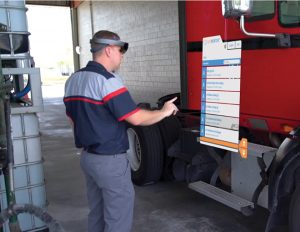Augmented Reality is effective because it is more interactive than solutions currently used. Technicians will develop muscle and mental memory faster than relying on printed documentation. As a result, you will see a reduction in mean time to repair. The return on investment can be significant.
By Matt Johnston
The Bureau of Labor Statistics suggests there will be a shortfall of approximately 75K heavy truck service technicians by the year 2022 mainly due to retirements. That is only two years away! This exodus of knowledge and skill is often termed the “silver tsunami”. This impending tsunami threatens to dramatically reduce fleet maintenance productivity.
So why should a fleet invest in an augmented reality (AR) maintenance and training software solutions? Not only are the next generation of technicians growing up in a world with AR on their mobile phones, but the trucking industry is also competing for this talent with industries that are already investing in this technology. Firms in manufacturing, aviation and utility sectors are making significant investments in augmented reality to support a significant amount of use cases including maintenance training and repair.

Photo courtesy of Design Interactive.
Why Augmented Reality?
Simply put, AR is the most effective way to train and instruct. Augmented Reality keeps a technician’s hands on their tools, head up, while visualizing real-time data or providing instructional overlays otherwise buried in a binder or a difficult to search intranet database. In short, it keeps the technician productive and can accelerate their acquisition of knowledge because they can learn by doing, not just watching or reading. Experts can be empowered to rapidly share their knowledge too.
Today, when an expert is called to help solve a problem, they have limited or no means to share how they solved the problem with other technicians, particularly those remote—AR solves that. The expert can create step-by-step guidance, capture videos or use virtual sticky notes and audio clips. The guidance is stored in the cloud, downloadable by any other technician across the enterprise. Now a technician can reference the most up-to-date expert guidance hands free, increasing productivity and reducing errors, which increases uptime and decreases part and labor costs. Let’s explore the top five reasons why you should invest in AR technology.
#1: Hands Free
Unlike paper presentations, AR is experienced through a heads-up display. This keeps your hands free. Instead of holding pages from a training manual, technicians can be hands on. This builds muscle memory. A technician learns better while doing. With information heads up, they can measure a king pin or inspect the feel of potential irregular tire wear instead of flipping pages or using a mouse to navigate on the computer in the maintenance bay.
#2: 3D Imagery
Printed repair guides may include 2D pictures or complex diagrams. Spatial AR presents more detail in 3D holograms. Imagine a technician inspecting wear on a tire walking around 3D holograms of one sided or river wear, comparing directly to the tire on the tractor. Compare this to a 2 inch by 2-inch 2D close jpeg of the same type of wear. Which content do you think would be more effective?
#3: Spatial Visualizations
Currently, if a technician needs a diagram, they have to print it out and reference it every time they need to reference a certain procedure. With augmented reality technology, you could place that same diagram directly in their field of view. It is always available in a convenient location. They can import a diagram, place it right in the field of view of a technician considering where they will be looking during their procedure.
#4: In the Shop, in the Classroom, it is Flexible
When you need to train new technicians, the trainer is typically confined to the classroom with PowerPoint presentations. This type of training style leaves room for errors, inconsistent training outcomes and increased repair cost in the future. With AR, you can train anytime, anywhere. It allows your experts to import virtual models of the part that they wish to train on with step-by-step instructions to walk your technicians through the repair process. This results in a decrease in overall training time, an increase in compliance and higher training standards.
#5: The Next Generation Expects It
AR Is inevitable. Large companies such as Apple and Google have made huge investments in AR software and hardware. Others are following to enable software to run in the cloud. Therefore, AR will be available to everyone. You should expect the next generation will use AR daily on their phones very soon. Schools are using it to educate and vocational schools agree that it is a great technology to train new technicians.
Return on Investment
AR is more effective not just because it can be heads up, but because it is also more interactive than solutions used today like YouTube videos. Technicians will develop muscle and mental memory faster than VR or relying on printed documentation. As a result, you will see a reduction in mean time to repair. The return on investment can be significant.
The “silver tsunami” is real. Experts will leave a massive knowledge gap and the pool of qualified new candidates is shrinking. You need to start making sure that knowledge is handed down and AR can help. As a trusted maintenance expert once told me this “genie can’t be put back in the lamp”.
Matt Johnston is Commercial Solutions Division Head for Design Interactive (Orlando, FL). He leads the development of AUGMENTOR™, an augmented reality software for maintenance and repair. He also serves as the chair of the AR/VR Task Force for the American Trucking Association’s Technology and Maintenance Council. Matt can be reached at (352) 278-3050, e-mail [email protected]t or visit LinkedIn at www.linkedin.com/in/matthew-r-johnston.
References
• www.bls.gov
• https://en.wikipedia.org/wiki/The_Silver_Tsunami
